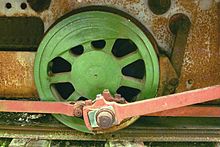- Coupling rod
-
A coupling rod or side rod connects the driving wheels of a locomotive. Steam locomotives in particular usually have them, but some diesel and electric locomotives, especially older ones and shunters, also have them. The coupling rods transfer the power to all the wheels.
Contents
Development
Locomotion No 1 was the first locomotive to employ coupling rods rather than chains. In the 1930s reliable roller bearing coupling rods were developed.
Balancing
The coupling rod's off-center attachment to the outside of the driving wheel inevitably creates an eccentric movement and vibration when in motion. To compensate for this, the driving wheels always had built-in counterweights that somewhat offset the angular momentum of the coupling rods. This vibration reduction was more effective when the rods move horizontally and less so when they are moving vertically. A counterweight is clearly visible at the top of the wheel in the image.
Coupling rods move in vertical motion as well as horizontally as the wheels rotate, but the engine's piston and its immediate attachments only move horizontally. Because the momentum of the connecting rods alone in up and down motion is considerably less than that resulting from the combined horizontal movement of the connecting rods, piston and driving rod, a wheel counterweight cannot be made to balance the entire assembly perfectly during its complete rotation. The counterweights have to be fixed in one position on their driving wheel to avoid a design complexity that would be both unreliable and unmaintainable.
An inevitable vibration that results during the complete circular movement of the driving wheels and rods is called hammering and it is destructive to both the locomotive and the roadbed. In some locomotives, this hammering is so intense that at speed, the drivers alternately jump from the rail head, then slam down hard on the rails as the wheels complete their rotation. Unfortunately, hammering is inherent to conventional two-cylinder piston-driven steam locomotives and that is one of the several reasons they have been retired from service.
Materials
Initially, coupling rods were made of steel.[citation needed] As technology progressed and better materials became available, the connecting rods were manufactured of lighter and stronger alloys[citation needed], which in turn permitted smaller counterweights and also reduced hammering.
See also
Categories:- Locomotive parts
- Steam locomotive technologies
- Rail transport stubs
Wikimedia Foundation. 2010.

